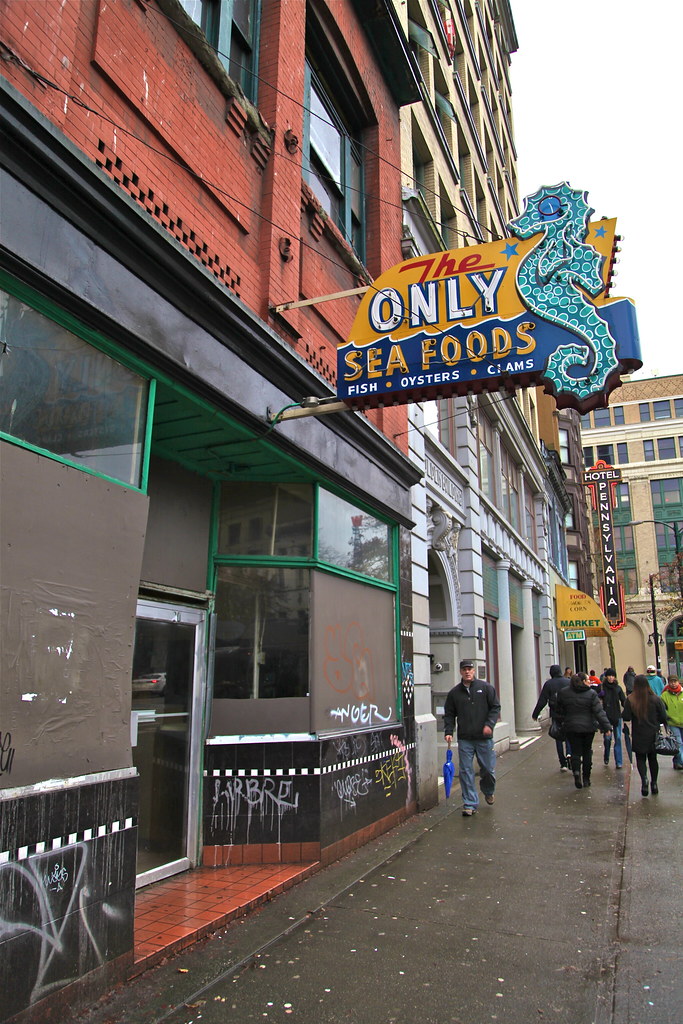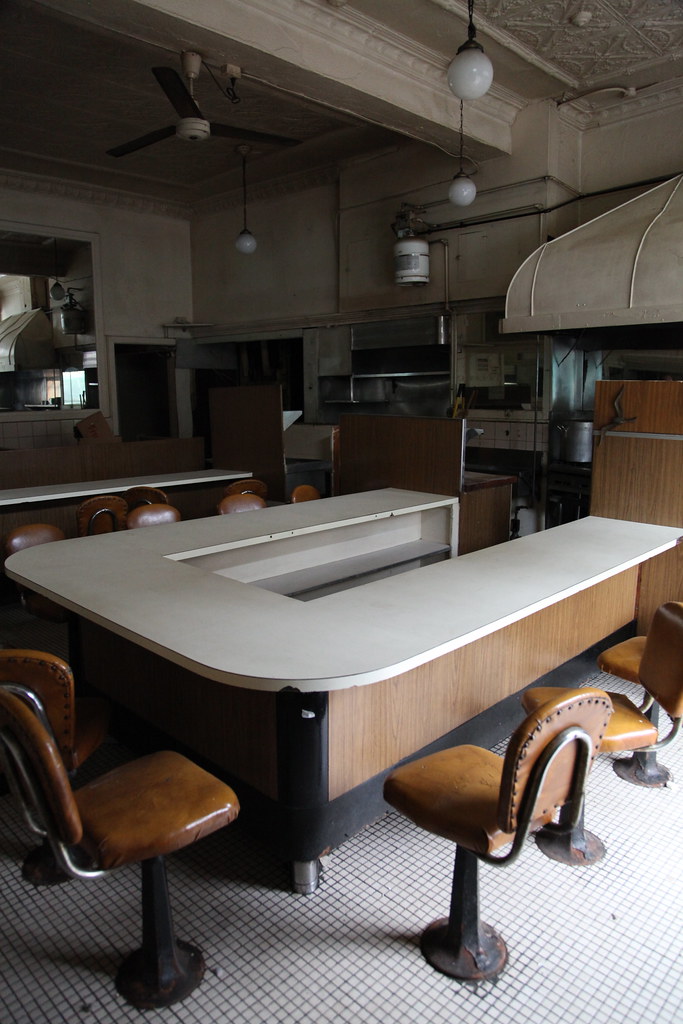
-
DTES Ovaltine Cafe
-
The southeast corner of Hastings & Columbia
-
Taking a break on the DTES. #skills
-
Neighbourhood Council
-
Ted Harris Paint, DTES, E Hastings
-
Community Gardens Hawkes and E Hastings
-
Rainy on the DTES
-
Pat
-
Save On Meats on Hastings Street
-
Old Salvation Army Building, DTES
The Downtown Eastside (DTES) is a catch all descriptor for the neighbourhoods east of Cambie, west of Clark, north of Prior, and south of the waterfront. Technically, it includes Gastown, Strathcona, Chinatown, and Railtown/Japantown, but we’ve separated each of these for their individual characters and are treating the DTES here much as the zeitgeist does: as the slowly shrinking collection of blocks east of Carrall, west of Jackson, north of Pender, and south of Cordova. If you have a different interpretation of the landscape and its borders, good for you!
Sadly, it’s safe to say that most Canadian’s view the DTES as less as a community and more of a sensational eyesore; an urban blight box crammed with a loose association of kid-gloved petty criminals, dealers, addicts, and people with mental health issues operating in and around bed bug-infested Single Room Occupancy hotels, daily dodging a very real minefield of violence and disease in often third world living conditions.
That might appear to be superficially true, but the reality is a lot more complicated and nuanced. The DTES is not, for example, “Canada’s poorest postal code”, as it is so often claimed. Neither is it Vancouver’s most transient neighbourhood (that distinction goes to the West End). And if you ask a resident if they feel like they belong to a genuine community, the answer will be a resounding “yes”.
A fierce sense of belonging would naturally coalesce and strengthen in any neighbourhood that was so institutionally demonized, referred to constantly from within and without as “a huge problem”. By policing it in a petty and punitive fashion, insulting it passive aggressively (or fully in the face), trying to price its residents out, or even pretending that it doesn’t exist, the people who see it as an abomination (or rather as a financial opportunity) have only made the community more suspicious of (and resistant to) change.
To wit, “The Downtown Eastside needs to be destroyed,” an editorial in The Province newspaper has declared. “The more residents who are pushed out, the better. It is unconscionable that such a hellhole should exist in a province as wealthy as B.C., in a country as advanced as Canada.” Now, if someone wrote that kind of trash about you and where you lived, you’d likely get your back up, too. Because not everyone who lives on the DTES fits the hysterical stereotype, and those that do are not so bereft of humanity as to not notice when someone tries to rob them of what little humanity they have left.
Indeed, if there’s anything to celebrate on the DTES, it’s that in spite of the high instance of mental illness; homelessness; the AIDS and Hepatitis C epidemics; heroin, crack cocaine, and crystal meth; a long and horrifying history of sexual abuse (before Robert Pickton, violence against First Nations women was treated as a fact of life on the DTES); and the way in which the rest of the city – not to mention the provincial and federal governments – views it through the prism of a largely unsympathetic corporate media; the DTES remains a strong, vibrant, and essential facet of Vancouver that – to its eternal credit – isn’t afraid to stand up for itself.
While other neighbourhoods protest against comparatively first-world affronts like bike lines, casinos, art installations, high rises, and funeral homes, residents of the DTES’ dwindling core demonstrate for vital services and in opposition to real or perceived threats against their ability to remain residents. They don’t always protest wisely (targeting small businesses is a nonsensical exercise in quixotic futility), but that they organize and advance a message that needs to be heard by all citizens despite often crippling circumstances is as commendable as it is all too often tragically ignored.
Looking around the DTES today it’s sometimes hard to imagine that it was the beating heart of Vancouver less than a century ago. The banks, the newspapers, the courts, even City Hall once called it home. But while it’s important to remember that the neighbourhood wasn’t always as it is now, romancing the DTES’ past or speculating on its future belittles a present crisis that doesn’t have much in the way of room for halcyon reminiscences or high hopes. The area needs help, and it needs help now; help that new condos and businesses can’t directly give. It requires assistance from the provincial and federal governments in the form of new, affordable housing, a long overdue increase to the welfare shelter allowance of $375 per month (there has only been only one increase since 1992), the non-politicization of harm reduction programs, and – in a hurry – a serious approach to mental health care that includes new facilities, preferably located in whichever affluent neighbourhood complains about them the most.
Change on the DTES is a good thing, and we’re all for it, just so long as it’s first and foremost for the people who already call it home.


 Left to right: Pat’s Lager at Pat’s Pub in the Patricia Hotel; Victorian era purple/blue glass basement prisms; Ovaltine Cafe neon tri-colour; the grass of Oppenheimer Park; Carnegie Community Centre; duo of road colours at Main & Hastings; No. 5 Orange; dormant Salvation Army building exterior at Gore & Main; VPD blue; needle tip orange.
Left to right: Pat’s Lager at Pat’s Pub in the Patricia Hotel; Victorian era purple/blue glass basement prisms; Ovaltine Cafe neon tri-colour; the grass of Oppenheimer Park; Carnegie Community Centre; duo of road colours at Main & Hastings; No. 5 Orange; dormant Salvation Army building exterior at Gore & Main; VPD blue; needle tip orange.


INSITE, THE CONTROVERSIAL BUT LIFE-SAVING SAFE INJECTION SITE
THE SAD, FORLORN EMPTY SHELLS OF THE ONLY AND THE LOGGER’S SOCIAL CLUB
THE RAMP CAM AT THE SMILING BUDDHA SKATEPARK
A COMPETITIVE MARKET FOR STREET CIGARETTES
THE GOOD WORKS OF THE PORTLAND HOTEL SOCIETY
THE INCOMPARABLE INTERIOR OF THE OVALTINE CAFE
BARGAIN HUNTERS COMBING THE PIGEON PARK STREET MARKET
THE CRUEL AND UNUSUAL ASSHOLERY OF SOME OF THE STREET-LEVEL DRUG DEALERS
A NETWORK OF ALLEYWAYS THAT ARE BEST AVOIDED
SWEET DUDS AT COMMUNITY & THE FROCK SHOPPE
OLD, RESPECTFUL GUYS WHO YELL “KIDS ON THE BLOCK” WHENEVER PEOPLE WALK PAST WITH CHILDREN




– In 1917, the Food Floor in Woodwards at Hastings & Abbott was the largest of its kind in the world.
– Vancouver’s City Hall was formerly located next to Carnegie Centre at Main and Hastings.
– The bell at St. James’ Church (then on Powell and Main) was, for many, the warning siren of the Great Fire in 1886; the melted remnants can be found at the Vancouver Museum.
– The First Nations name for Crab Park (Portside) is Lucklucky, meaning “Grove of Beautiful Trees”. The name “Crab” originates from the Create a Real Available Beach (CRAB) initiative by DTES residents in the early 1980s.
– In 1989 Vancouver launched North America’s first needle exchange program in an effort to promote harm reduction for residents of the Downtown Eastside. In 2003 North America’s only legal supervised injection site, Insite, was founded.
– The multi-height, 45 ft. wide half-pipe at the Smiling Buddha was built using the bones of several historic Vancouver skate ramps, including the original Richmond Skate Ranch and the Expo ’86 vert ramp.

-
Ovaltine Cafe Counter Service
-
A favourite plate from dinner at Pidgin on Friday night: mushrooms, snap peas, soy yuzu brown butter @pidginyvr.
-
DTES
-
Rainy Wednesday night on Hastings St. #dtes #astoriahotel
-
East Van Roasters | Shelley Bolton
-
Capless? Evidence of idiocy on Dunlevy
-
Opening night at Gastown's Bitter Tasting Room
-
Nelson The Seagull
-
Freedom on Hastings Street
-
Rainier Provisions
-
Bitter Tasting Room
-
Bitter Tasting Room
-
-
DTES Ovaltine Cafe
-
Dunlevy Snackbar | 433 Dunlevy
-
Foggy Hastings Street
-
Sean Heather with a barrel of extra virgin olive oil at Rainier Provisions
-
St. James Church DTES
-
Hotel Balmoral
-
Hotel Balmoral
-
Bitter Tasting Room
-
Picked & Sprout pop-up dinner at Nelson The Seagull
-
Picked & Sprout pop-up dinner at Nelson The Seagull
-
Picked & Sprout pop-up dinner at Nelson The Seagull
-
DTES Dude
-
Indoor Skate Ramp | DTES
-
DTES Hastings in the fog
-
DTES mural
-
Ovaltine Cafe Specials
-
Green Guitar
-
Detail inside East Van Roasters
-
Theo At The Dunlevy Snackbar
-
Dunlevy Snackbar
-
Hastings Street
-
DTES Woodbine
-
Rainier Provisions
-
East Van Roasters | Portland Hotel Society
-
Rainier Provisions
-
DTES Alley summer evening Photo by Michelle Sproule
-
DTES Hastings
-
Solder & Sons Books
-
Bitter Tasting Room
-
Rainier Provisions
-
Nelson The Seagull
-
DTES i love you
-
Ovaltine
-
Astoria by Day
-
Ted Harris Neon Sign
-
Au Petite Chavignol - E Hastings St
-
-
East Van Roasters
-
Bitter Tasting Room
-
The Astoria
-
Rainier Provisions
-
Heatley Block 2011
-
DTES Iron Works
-
The Only
-
DTES Dumpster
-
Boxing Ring at The Astoria Hotel
-
The Astoria Boxing Club
-
-
The Astoria Boxing Club
-
The Astoria Hotel
-
Power Shandi at The Astoria
-
East Van Roasters Interior
-
Ovaltine Cafe
-
Empress Hotel
-
Cruising DTES
-
PHS Community
-
Powell Street Festival
-
Powell Street in August
-
Oppenheimer Park
-
DTES Paste-up
-
The Only | possible retail space next door
-
Parke Cafe
-
DTES Paste-up
-
East Van Roasters
-
Building Detail
-
image
-
Hastings Street Late Spring
-
DTES Tulip
-
Writers Exchange | Sarah Maitland and Jennifer MacLeod
-
Staff Winnowing Cacao at Eastvan Roasters
-
The Only
-
The old gambling hall diner above The Only on East Hastings #dormantawesomeness
-
Fat Dragon
-
Fresh chocolate at East Van Roasters
-
Save On Meats Signage
-
The Only
-
Snacks at The Dunlevy
-
Still Life at Save on Meats
-
Nelson The Seagull
-
Nelson The Seagull
-
HONOURABLE MENTIONS
-
Old Faithful Bread delivery from Nelson The Seagull
-
The Only
-
PiDGiN
-
The Only, DTES
-
The Only | Exterior signage
-
Burger Time at Save On Meats
-
Mark Brand | Save On Meats
-
DTES Ovaltine
-
The Dunlevy Snackbar
-
The Dunlevy Snackbar
-
Street Market | DTES
-
Lunch at Nelson The Seagull
-
-
Nelson The Seagull
-
Au Petite Chavignol - E Hastings St 2
-
Red Light on the DTES
-
Beats & Bikes
-
Nelson The Seagull
-
Potatoes?
-
PiDGiN | Beef Tataki
-
Rainy on the DTES
-
Hastings St Puddle
-
DTES School
-
Nelson The Seagull © Scout Magazine 2011
-
Nelson The Seagull
-
The Only
-
Powell Street Festival,
-
The Only
-
Sole Food
-
Paste Up
-
PiDGiN
-
Hastings on rainy summer night
-
Sole Food
-
Sole Food
-
The Only
-
DTES Studio Space
-
Nelson The Seagull
-
Street Market
-
Homesteaders Emporium
-
Nelson The Seagull © Scout Magazine 2011
-
Homesteaders Emporium
-
Rick at Homesteader’s Emporium
-
Chef Makoto Ono | PiDGiN
-
Smiling Buddha Cafe
-
DTES colour study
-
Sole Food Rice

































































































































































